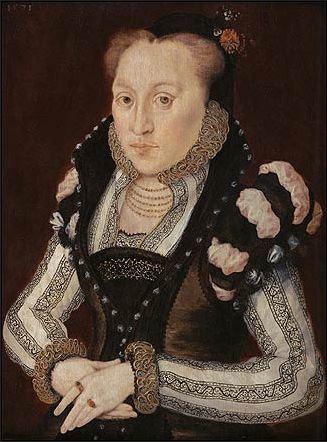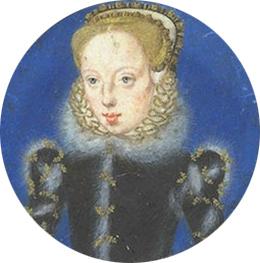
As long time readers of this here blog will no doubt remember, I was a huge fan of Elizabeth Fremantle’s debut novel, Queen’s Gambit, which gave the reader a peep at the life of Catherine Parr, whom I’d probably say is my most favorite of Henry VIII’s wives, if asked at gunpoint and really FORCED to choose. Otherwise it’s probably a close call between all six to be honest.
I really loved Fremantle’s peppy, good natured and vaguely irreverent tone, which I thought translated well to the period (I mean, come on, the Tudors were utterly RIDICULOUS when you think about it) and also really made the character of the witty, wryly humorous and kind hearted Catherine herself blossom and come to life. It’s a fun read and one that I highly recommend.

Presumed portrait of Elizabeth I, Levina Teerlinc (although attributed to Nicholas Hilliard by the Royal Collection), c1565. Photo: Royal Collection.
I was REALLY looking forward, therefore, to the second installment of what I believe to be a very wide ranging trilogy set at the Tudor court and have to say that I wasn’t the slightest bit disappointed as Sisters of Treason is every bit as rollicking, detailed and immersive as its predecessor, perhaps even more so.
As you may have guessed from the title, Sisters of Treason focusses on the stories of the Grey sisters Catherine and Mary, beginning with the execution of their elder sibling, Jane, who makes a brief but moving appearance then proceeds to cast a long shadow across the rest of the book. Lady Jane Grey has undergone many different interpretations recently, many of which overturn the whole mawkishly innocent Protestant painted little saint of Victorian hagiography and Delaroche’s iconic painting and instead paint her as a much less likeable and obdurate religious bigot with a sharp tongue and entitled manner. Fremantle’s depiction falls somewhere between the two – her Jane is graceful yet firm, kind yet principled and would, as at least one character notes sadly, almost certainly have made a much better Queen than any of her cousins.

Lady Mary Grey, Hans Eworth, 1571. Photo: Chequers.
What I really liked though about Sisters of Treason is that yet again the whole mythology that has sprung up about the Greys being HORRIBLE parents and poor miserable Jane being hothoused, helicoptered and beaten to within an inch of her life has been ignored as the nonsense that it most probably is and instead we are treated here to a depiction of the surviving Greys, mother and daughters, as a close knit, affectionate family who’d actually much rather do without the push and shove and ambitions of the Tudor court and would much rather marry and lead quiet domestic lives. It’s their particular tragedy that they are never allowed to do this and indeed the main crux of the novel is the disasters that befall both sisters after they feel forced into making secret marriages against the knowledge of their cousin, Elizabeth, who here is depicted as completely failing to appreciate the consequences of keeping her closest cousins and putative heiresses at such a distance and effectively alienating them from herself.
Although I found it hard to totally warm to ditzy, thoughtless Catherine Grey, I really loved her younger sister, Mary. Dismissed by an ambassador as ‘little, crook-backed and very ugly’, Mary very likely suffered from dwarfism and must have made quite a marked contrast to her by all accounts unusually good looking elder sisters (they were the granddaughters of the famously lovely Mary Tudor after all). However, here she is depicted as something like the Tyrion Lannister of the family – the brightest of them all and the one who has learned to use her size to her advantage when it comes to avoiding attention. It is through Mary’s eyes that we see the Tudor court at its most ugly, status obsessed and cruel, whereas to her giddy, foolish sister Catherine (ironically we are reminded that she was named for Catherine Howard, who was Queen at the time of her birth in August 1540) it is a place of feckless entertainment and romance. It is a brutal, colourful world of stark contrasts and one that the ill equipped Grey sisters, neither of whom have the powerful protectors and pampered background of Mary of Scotland or the cold headed ‘school of hard knocks’ cunning of Elizabeth Tudor (who reminded me in this book of a gravel voiced, hatchet faced, grim minded crime family matriach in a Martina Cole novel – yes, she really is that horrible), have to navigate as best they can.

Lady Catherine Grey, Levina Teerlinc, c1555. Photo: Victoria and Albert Museum
The sisters themselves are observed by family friend Levina Teerlinc, who paints and sketches the sisters and their mother while at the same time supporting them through the trials, perils and problems that beset them. I’m not a massive fan to be honest of the particular genre of historical fiction that revolves around a trade person gatecrashing historical events (oh, you know the sort of thing – it has someone who makes mirrors becoming IMPROBABLY privy to the secrets of Louis XIV’s court or a printer’s apprentice getting embroiled in the Wars of the Roses or Anne Boleyn’s confectioner witnessing her downfall or WHATEVER) but I really did enjoy Teerlinc’s bits of the books as they were written with a light touch and her inclusion really did bring the whole book alive, mainly because she was given such a warm character and is the sympathetic glue that keeps the others in line. Also, while Catherine and Mary show us both the perilous and glamorous sides of court life, it is Lavina, the bystander who has just enough distance from their situation to see how precarious and fraught with danger their apparently exalted position as prospective heirs to the throne actually is, although like the reader and the sisters themselves she is powerless to do anything to stop their inevitable disgrace.
A study of the dark side of the glittering Tudor court and a reminder of why it wasn’t exactly as MARVELLOUS as you might think to be too close to the throne, Sisters of Treason is a knock out, meaty, entertaining and often bittersweet read (the ending had me weeping BUCKETS) that I’d recommend to any historical fiction fans but especially the ones who are fed up with the hoary same old same old coifs and pomanders Tudor fare that’s being churned out right now and in search of something fresh and engaging to read.

Lady Catherine Grey and her son Lord Edward Beauchamp, unknown artist, c1562. Photo: Collection of the Duke of Northumberland.
******
Set against the infamous Jack the Ripper murders of autumn 1888 and based on the author’s own family history, From Whitechapel is a dark and sumptuous tale of bittersweet love, friendship, loss and redemption and is available NOW from Amazon UK and Amazon US.
‘Frothy, light hearted, gorgeous. The perfect summer read.’ Minette, my young adult novel of 17th century posh doom and intrigue is now 99p from Amazon UK and 99c from Amazon US. CHEAP AS CHIPS as we like to say in dear old Blighty.
Blood Sisters, my novel of posh doom and iniquity during the French Revolution is just a fiver (offer is UK only sorry!) right now! Just use the clicky box on my blog sidebar to order your copy!
Follow me on Instagram.
